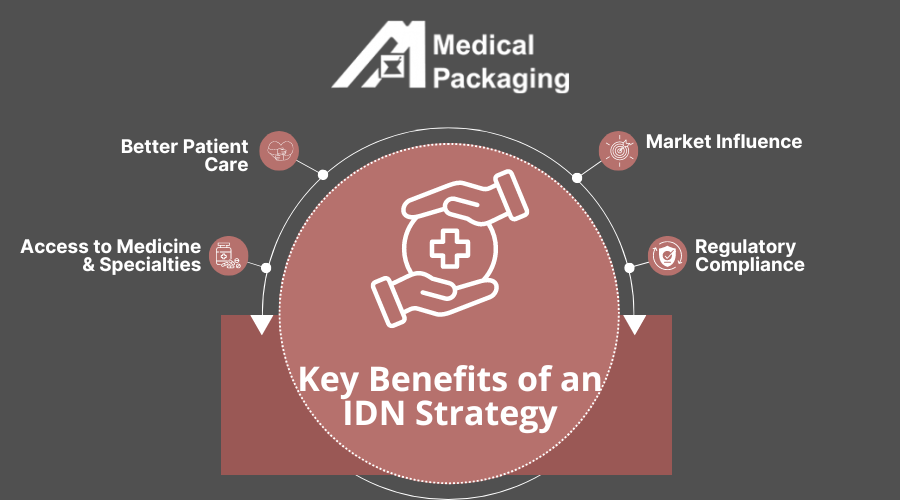Increasing Safety & Efficiency in Integrated Delivery Networks
The rise of integrated delivery networks (IDNs) is contributing to higher-quality patient care, better patient outcomes, and other positive trends in the United States healthcare industry.
These trends reflect how IDNs make it easier for healthcare facilities to provide patients with comprehensive treatment at a lower cost. IDNs offer a comprehensive range of services within their network, including the management of chronic conditions, acute care for injuries and illnesses, and specialized attention to other health needs, ensuring coordinated and continuous care across the entire healthcare spectrum.
IDNs have played a significant role in driving growth and innovation within the healthcare industry, delivering key benefits while also encountering various challenges. But what exactly is an Integrated Delivery Network, and how can we enhance safety and efficiency to realize its full potential?
What Are IDNs?
IDNs are healthcare networks that are made up of a group of healthcare providers. These systems own and operate a network of healthcare facilities, which can include several types of outpatient and inpatient facilities, such as:
- Hospitals
- Health clinics
- Physician groups and practices
- Ambulatory surgery centers
- Imaging centers
Example of an IDN
An example of an Integrated Delivery Network (IDN) is Kaiser Permanente.
Kaiser Permanente is one of the largest and most well-known IDNs in the United States. It combines hospitals, outpatient clinics, and a network of physicians into a unified organization. The key components include:
- Hospitals and medical centers: Kaiser owns and operates its hospitals and outpatient facilities, ensuring that patients receive care within their own system.
- Physician network: Physicians employed by Kaiser Permanente are part of a large group practice, providing both primary and specialized care.
- Health insurance: Kaiser also operates its own health plan, providing coverage and streamlining payment systems for its patients.
By integrating these various healthcare services and systems, Kaiser Permanente offers more coordinated and efficient health services for patients, emphasizing preventative care and long-term health management.
Types of Integrated Delivery Networks
Various levels or types of IDNs exist. These organizations are categorized based on factors such as how many healthcare facilities are included, how they make strategic decisions on healthcare costs, care coordination, and other aspects of healthcare delivery. IDNs fall under one of the following categories or levels:
1. Horizontal Integration (System II)
Horizontal integration IDNs, or System II IDNs, typically include multiple hospitals, although some include other kinds of healthcare facilities as well. National or regional hospitals can be part of these healthcare systems. System II networks can also include state, government, and even investor-owned IDNs.
2. Vertical Integration (System III)
Vertical integration, or System III IDNs, includes a wide range of different healthcare facilities and medical centers. This type of health system focuses on providing a care continuum for a patient population that includes all ages. System III networks offer care that allows patients to stay within the integrated delivery system throughout their lives, from pediatric care to geriatric care in a long-term care facility. In addition to primary care and specialized care, healthcare services that are often part of these networks include prenatal care, hospice, and assisted living, all working to increase the net patient revenue. Community health IDNs typically fall into this category, as do academic health systems and faith-based health systems.
3. Strategic Integration (System IV)
Strategic integration IDNs, or System IV IDNs, also use vertical integration to share healthcare resources equally among all facilities rather than focusing on one type of facility. However, decision-makers within these networks follow a sophisticated IDN strategy to manage healthcare delivery, considering various aspects of the system, such as purchasing decisions and resource allocation.
Key Benefits of an IDN Strategy
IDNs provide important advantages in terms of patient outcomes and healthcare delivery. These networks can offer the following benefits, whether they are classified as System II, System III, or System IV.
Enhanced Patient Care
IDNs have a distinct advantage when it comes to providing high-quality care. With a wide network that connects valuable resources and specialties, IDNs are in a unique position to offer improved clinical outcomes. They can contribute to improvements in overall population health and better outcomes in their existing communities.
Access to Medicine and Specialties
Being part of an IDN often means that a healthcare provider does not have to refer patients to out-of-network providers for specialized services. For example, cancer patients can receive all the care they need within an IDN through their health plan, including chemotherapy or other treatments, nutrition services, and care for other health conditions. Access to medicine and specialty healthcare professionals can help improve the healthcare ecosystem by providing the right care at the right time.
Market Influence
IDNs have a significant impact on market influence, which can help provide better control over healthcare costs. This can lead to more affordable care for patients to help ensure that they receive the services they need. The strong market influence of IDNs can also result in more efficient healthcare delivery, leading to lower operating costs for hospitals and other healthcare facilities.
Regulatory Compliance
One of the key advantages of an IDN strategy is its ability to streamline regulatory compliance across all facilities within the network. IDNs ensure that all their providers follow the same regulatory guidelines, including patient safety protocols, data privacy regulations (such as HIPAA), and clinical best practices. By coordinating compliance efforts, IDNs reduce the risk of legal issues, improve patient trust, and enhance overall healthcare quality.
Navigating Challenges Faced by IDNs
While IDNs offer notable benefits, they also face certain difficulties. Healthcare reform and financial challenges are causing more hospitals and other healthcare facilities to consolidate to form these networks. This growth has led to a variety of challenges within everyday operations such as:
Supply-Chain Issues
Supply chain issues have had an impact on many industries, including healthcare. Drug shortages have a direct effect on the quality of care patients receive, as well as patient outcomes. IDNs can take steps to minimize the risks of supply chain shortages by turning to trusted sources and establishing healthcare product safety nets to alleviate disruptions in the supply chain.
Incompatible Network Communications
The flow of information and data is a critical part of integrated delivery networks. Managing such large-scale and complex information systems comes with an abundance of challenges and potential for problems. When it comes to investing in these systems, there are various considerations to keep in mind to maintain efficiency. A few of those considerations are:
- Usability
- Network capabilities
- Data management
How MPI Improves Efficiency in Integrated Delivery Networks
As a leader in the industry, Medical Packaging Inc., LLC (MPI) aims to increase safety and efficiency within IDNs while assisting with some of their challenges. When an organization is looking to maximize the process of medical packaging and distribution, MPI products provide an efficient solution with the following benefits:
1. Network Capabilities
Our software meets all industry regulations while connecting your organizations under one centralized system. Staying connected and improving communications can help promote consistency across medication distribution.
2. Avoiding Supply Chain Disruptions
As pharmaceutical companies struggle to increase production and overcome supply chain issues, our solutions make it possible for IDNs to avoid these disruptions. Taking the packaging process in-house helps ensure that IDNs have access to all the medication needed for patients within the system. Our solutions provide reliable, compliant packaging materials, to reduce the reliance on yet another vendor.
3. Promoting Patient Safety
MPI helps improve patient safety by allowing the proper dosage to be packaged. Our products help reduce the risk of patients receiving the wrong medication dosage. The use of barcode scanning technology helps ensure efficient distribution among healthcare facilities in an IDN.
Exploring MPI’s unit dose medication packaging solutions allows IDNs to see how these products and services can streamline their operations and mitigate the challenges associated with medication distribution. By leveraging these solutions, IDNs can prioritize enhancing patient safety while delivering more efficient healthcare.
To learn more about MPI’s unit dose supply method or specific packaging products and services for IDNs, visit our website. Or contact MPI today to find the packaging solution that best fits your needs.
Resources
Organization. “Important Notices.” Kaiser Permanente, healthy.kaiserpermanente.org/georgia/front-door. Accessed 3 Oct. 2024.
(OCR), Office for Civil Rights. “Hipaa Home.” HHS.Gov, 19 Apr. 2024, www.hhs.gov/hipaa/index.html.
Badr, Yara, et al. “The Use of Big Data in Personalized Healthcare to Reduce Inventory Waste and Optimize Patient Treatment.” Journal of Personalized Medicine, U.S. National Library of Medicine, 3 Apr. 2024, www.ncbi.nlm.nih.gov/pmc/articles/PMC11051308/.
“U.S. Integrated Delivery Network Market Size, Growth, Report 2024-2033.” BioSpace, 16 July 2024, www.biospace.com/u-s-integrated-delivery-network-market-size-growth-report-2024-2033.
Contact MPI Today for Personal Assistance
MPI’s Drug Master File provides speed-to-market regulatory and technical support related to our packaging components for medical and pharmaceutical market clients

